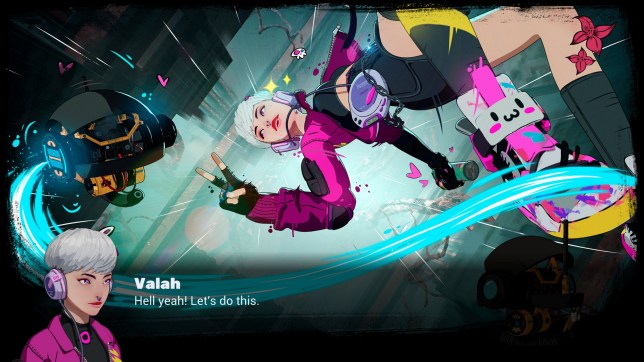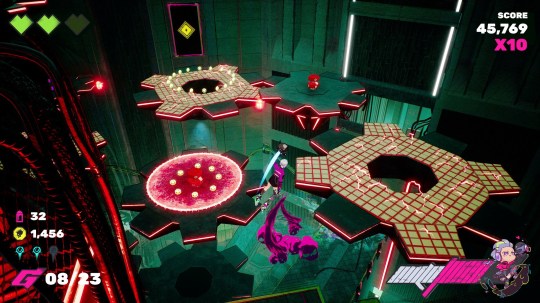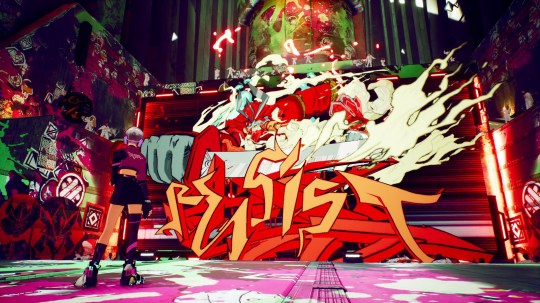A homage to late 90s action games looks like being one of the best indie titles of the year, with Wabisabi Games’ graffiti-based platformer.
Mexico isn’t exactly renowned as a hotbed of game development, but that perception may be about to change if Rakugaki (also known as RKGK) is a reliable indicator. Made by Wabisabi Games, Rakugaki’s super colourful, stylised look brings to mind the likes of Hi-Fi Rush and Jet Set Radio, married with high octane platform style gameplay that’s also influenced by early era 3D games.
We managed to catch up virtually with various members of Rakugaki’s development team and play a demo version of the game, which is due to come out on May 22 for PC (hopefully console versions will follow but they’ve not been announced). They came across as a sparky and articulate bunch, led by CEO and game director Anwar Noriega, who began by explaining that Rakugaki is a passion project for the team.
‘Rakugaki is a one-player 3D platformer inspired by the platformers of the late 90s and our love for Japanese pop culture – especially anime, manga, and electronic music – and graffiti culture. It’s a love letter or tribute to everything we loved as kids,’ says Noriega. ‘We used to watch anime and get up early on Saturdays to watch Dragon Ball and Ghost In The Shell, that ended up motivating us to create art,’ says art director Esteban Lezama.
Lezama and the rest of the team have certainly made a game with an unmistakable visual style, while still being reminiscent of the colourful, in-your-face visuals of Hi-Fi Rush and Jet Set Radio. It also does a magnificent job of melding anime and graffiti into a distinctive new form.
Graffiti also looms large in Rakugaki’s gameplay. Noriega explains that you play a character called Valah, a graffiti artist in a dystopian urban world, which is run by the evil Mr Buff (buffing, in the graffiti world, is what the authorities do when they paint over a piece). He has installed TVs showing his propaganda everywhere, which are turning Valah’s fellow inhabitants into compliant zombies, so her mission is to race through a series of levels with her trusty bot in tow, graffitiing over those TVs and thereby redressing the balance.
Valah doesn’t just produce common-or-garden graffiti: at various points in each stage she comes across huge screens which she daubs with vibrant multimedia epics, that have animated elements, a 3D effect and often notable visual references to more local art styles for Mexico-based Wabisabi, such as lucho libre masks and the distinctive look of Day of the Dead.
Even in general gameplay, she continually sloshes coloured spray paint around previously near-monochrome surfaces; Rakugaki certainly provides a sense of putting the colour back into a world which has been washed out to grey, in a pleasingly anarchic manner.
Noriega also explained the game’s name, admitting that some may find it tricky to pronounce, hence the option, in the modern vowel-obliterating manner, to reduce it to RKGK. He explained: “Rakugaki is a Japanese word, essentially meaning a doodle or a sketch done by kids. About 30 years ago, Japanese police and the government started calling graffiti Rakugaki in a negative way. But Japanese graffiti artists started using it as a thing, calling themselves Rakugaki artists.”
We managed to sample Rakugaki’s gameplay via a three level demo, with Wabisabi revealing that the full game will consist of 30 levels arranged in six chapters, which can be completed in around six hours. Completists could squeeze up to 12 hours of gameplay from it, aided by a number of challenges attached to each level and the usual plethora of collectables, both overt and hidden.
The first level, unsurprisingly, was a glorified tutorial, introducing Valah’s myriad moves at a judicious pace. Even though it was probably the slowest level in the game, it still managed to convey an agreeable sense of flow. Valah has typical platform style moves – a jump, double jump, horizontal dash jump, the ability to wall climb, and a far reaching melee provided by her robot
But she also has graffiti-powered moves, such as an ability that equates to surfing around on paint and which also deals melee damage to enemies she encounters head-on. There’s also a paint-powered hover jump and she can latch onto rails using the controller’s right bumper – although these rail slides can also be triggered a fair distance from the rail itself we still often had to narrow the gap beforehand with a dash jump.
While Rakugaki contains some pretty conventional platforming – there are checkpoints, crates to smash (often containing health-restoring hearts), and plenty of hard-to-reach areas – Valah’s paint-powered moves add a more unique element to the gameplay.
For example, you often find floor tiles which, if surfed over, yielded coins. And as Valah collects objects and takes out enemies through the course of each level, she builds up a Defacer meter which, when full, launches her into Defacer mode. At this point everything is enhanced, as she moves faster, jumps higher, and acquires a more powerful melee move.
It’s worthwhile building up to Defacer mode, as that is when Rakugaki really takes off, putting you into a flow state in which chaining combos brings rewards, in terms of both sheer gameplay satisfaction and an even greater visual feast than the game provides in its base state.
As you get to grips with the controls – which are pretty nicely fettled – you learn how to extend these Defacer mode runs, which will be brought to an abrupt end if you take any damage or demonstrate much hesitancy or indecision. You’re given a rating at the end of each level, and you really need to nail those Defacer mode runs to get into the A and S-ratings.
That said, there are times in Rakugaki when you’ll want to take a more considered approach. Its level design (which felt pretty exemplary on the limited evidence provided by the preview demo) can be pretty complex, and some of Mr Buff’s screens are hidden away from the beaten track. Graffitiing over them earns you one of the game’s currencies, which you will need to unlock new stages, so going back to find the ones you’ve missed provides an instant element of replayability.
Another in-game currency called Ghosts (which look like stylised ghosts, naturally) is habitually hidden in each level’s most obscure corners but will prove useful to anyone obsessed with customisation, as they can be spent in Valah’s hideout, which operates as Rakugaki’s hub.
You can use Ghosts to pay for new outfits and unlock new graffiti art which can be equipped so that Valah paints it on both the basic Mr Buff screens and the big screens. In the hideout, you can also tinker with Valah’s general graffiti colour palette, allowing you to pick your favourite hues to daub all over the levels.
Rakugaki’s difficulty curve felt just about right: the second level in the demo was a mid-game one which felt much more challenging than the first, introducing more dangerous enemies and elements, like containers moving in regular patterns that damage Valah with the merest touch. Wabisabi said the game has two difficulty levels – the default one, and a harder one designed for ‘hardcore platformers,’ in which it becomes more difficult to trigger Defacer mode and Valah has less health.
The final level in the demo was a boss stage. Given that Rakugaki is split into six chapters, we can expect six of those. The one in the demo took an unconventional approach for a platform -game boss encounter: Valah didn’t engage with the boss itself, but had to evade laser-traps it sent out (whose direction of movement was signposted) then defeat normal-sized enemies it deployed as proxies. It was split into several stages and reinforced the impression that while Rakugaki is a platform-game, it does a pretty good job of avoiding platform-game cliches.
There are plenty of questions about Rakugaki that a three level demo can’t answer. Without the full game to play we can’t tell whether it builds in a coherent manner, whether its boss battles have sufficient variety, whether it ends up feeling like a relatively meaty game, or whether its storyline is at all compelling.
What we can say is that in terms of gameplay it feels fresh and distinctive, it looks fabulous in a commendably distinctive manner, and it has plenty of personality. If you’re a fan of fast-flowing, distinctive looking platformers, it should be well worth checking out, and will hopefully help to put another promising indie developer on the map.
Formats: PC
Publisher: Gearbox Publishing
Developer: Wabisabi Games
Release Date: 22nd May 2024
Email gamecentral@metro.co.uk, leave a comment below, follow us on Twitter, and sign-up to our newsletter.
MORE : Sea Of Thieves PS5 review – authorised PlayStation piracy
MORE : Final Fantasy 16 The Rising Tide DLC review – raiders of the lost Eikon
MORE : TopSpin 2K25 review – tennis comeback
Follow Metro Gaming on Twitter and email us at gamecentral@metro.co.uk
To submit Inbox letters and Reader’s Features more easily, without the need to send an email, just use our Submit Stuff page here.
For more stories like this, check our Gaming page.

Sign up to all the exclusive gaming content, latest releases before they’re seen on the site.
This site is protected by reCAPTCHA and the Google Privacy Policy and Terms of Service apply.
















